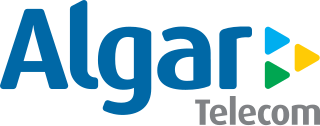The Eastern Africa Submarine Cable System (EASSy) is an undersea fibre optic cable system connecting countries in Eastern Africa to the rest of the world.

South East Asia–Middle East–Western Europe 4 is an optical fibre submarine communications cable system that carries telecommunications between Singapore, Malaysia, Thailand, Bangladesh, India, Sri Lanka, Pakistan, United Arab Emirates, Saudi Arabia, Egypt, Italy, Tunisia, Algeria and France. It is intended to be a complement to, rather than a replacement for, the SEA-ME-WE 3 cable.

Interoute Communications Ltd was a privately held telecommunications company that operated large cloud service platforms in Europe. On 23 February 2018, Interoute was acquired by GTT Communications for $2.3bn (€1.9bn); and the acquisition closed on 31 May 2018.

Alcatel–Lucent S.A. was a multinational telecommunications equipment company, headquartered in Boulogne-Billancourt, France. It was formed in 2006 by the merger of France-based Alcatel and U.S.-based Lucent, the latter being a successor of AT&T's Western Electric and a holding company of Bell Labs.
I-ME-WE is a 12,091-kilometre (7,513 mi) submarine communications cable system linking Europe and India via the Middle East. At launch, the design capacity was 3.84 Tbit/s, but after upgrades by Mitsubishi Electric in 2016, the new design capacity was rated at 5.6 Tbit/s. The cable entered service in December 2010.
Telecommunications in Angola include telephone, radio, television, and the Internet. The government controls all broadcast media with a nationwide reach.

The West Africa Cable System (WACS) is a submarine communications cable linking South Africa with the United Kingdom along the west coast of Africa that was constructed by Alcatel-Lucent. The cable consists of four fibre pairs and is 14,530 km in length, linking from Yzerfontein in the Western Cape of South Africa to London in the United Kingdom. It has 14 landing points, 12 along the western coast of Africa and 2 in Europe completed on land by a cable termination station in London. The total cost for the cable system is $650 million. WACS was originally known as the Africa West Coast Cable (AWCC) and was planned to branch to South America but this was dropped and the system eventually became the West African Cable System.

Africa Coast to Europe (ACE) is an optical-fiber submarine cable system serving 24 countries on the Europe, west coast and south Africa, managed by a consortium of 20 members.
SAex is a proposed submarine communications cable linking South Africa to the United States with branches to Namibia, Saint Helena, and Brazil.

Algar Telecom is a Brazilian telecommunications company present in the states of Goiás, Mato Grosso do Sul, Minas Gerais, Paraná, Rio de Janeiro, Rio Grande do Sul, Santa Catarina, São Paulo, and in the Federal District as well. The company is the only operator that remained private, even after the creation of Telebrás in the military regime, and it is characterized as the fifth largest company in the telecommunications segment. It serves more than one million and four hundred thousand customers - individuals, micro and small businesses, corporate customers, and carriers.

Angola Cables is an Angolan multinational telecommunications operator of fiber-optic telecommunication cables.
The South Atlantic Cable System or SACS, is a submarine communications cable in the South Atlantic Ocean linking Luanda, Angola with Fortaleza, Brazil with a leg connecting the Brazilian archipelago of Fernando de Noronha as well. It is the first low latency routing between Africa and South America.

EllaLink is an optical submarine cable linking the European and South American continents with landing points in Sines in Portugal and Fortaleza in Brazil. It has currently the lowest latency on the market.
La Guinéenne de la Large Bande is a limited company in charge of managing the capacity allocated to Guinea on the Africa Coast Europe submarine cable (ACE) since March 2013.
South East Asia–Middle East–Western Europe 5 is an optical fibre submarine communications cable system that carries telecommunications between Singapore and France.
West Indian Ocean Cable Company (WIOCC) operates as a wholesaler, providing capacity to international telecoms, cloud operators, content providers and internet service providers within and out of Africa. WIOCC offers carriers connectivity to over 550 locations across 30 African countries – utilising more than 75,000 km (47,000 mi) of terrestrial fibre and 200,000 km (120,000 mi) of submarine fibre-optic cable. WIOCC's international network reach currently extends to 100 cities in 29 countries in Europe and more than 700 cities in 70 countries globally.

NJFX, also known as New Jersey Fiber Exchange, is a Wall Township, NJ-based data center and subsea cable landing station operator. The company offers Tier 3 data center, meet-me room and colocation services, and a cable landing station on a 58 acre campus.
South East Asia–Middle East–Western Europe 6 is an in-progress optical fibre submarine communications cable system that would carry telecommunications between Southeast Asia, the Middle East, and Western Europe. Construction began in early 2022. It is expected to be operational in the first quarter of 2025 The expected cable length is 19,200 km and it has a design capacity of 126 Tbit/s, using SDM technology.
Grace Hopper is a private transatlantic communications cable that connects the United States of America with the UK (Bude) and Spain (Bilbao). It was announced by Google in 2020 and scheduled to go live in 2022. The US to UK (Bude) leg went live on 27 September 2022.









